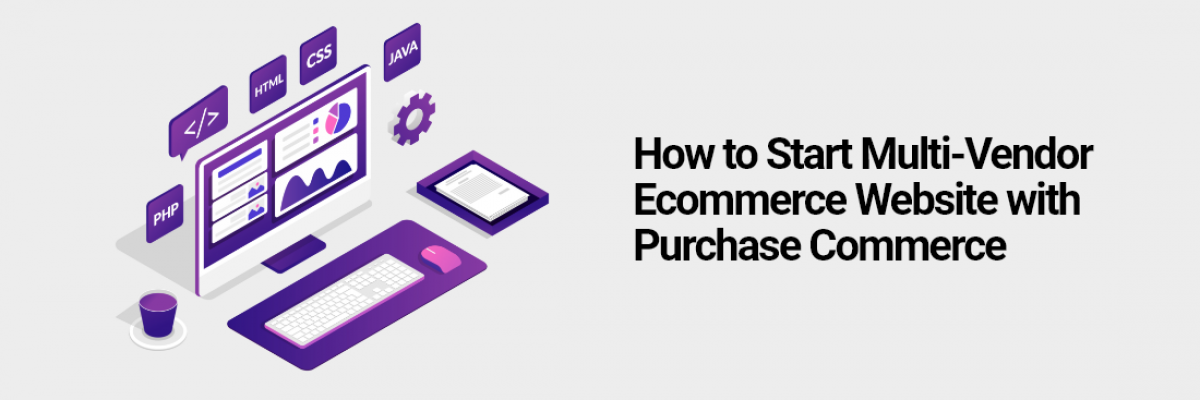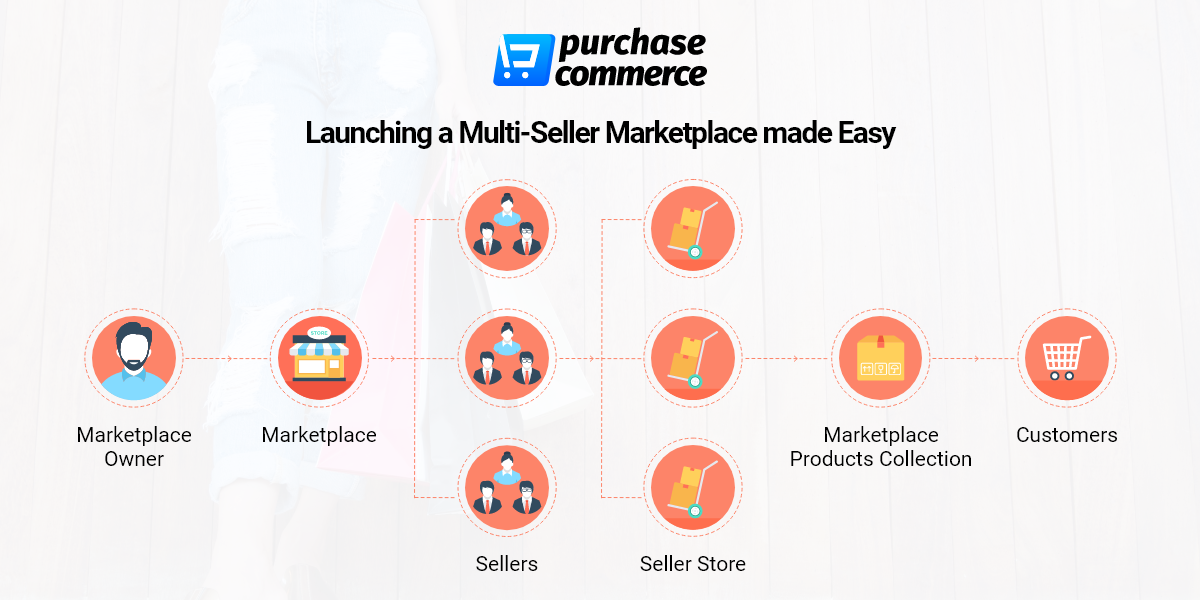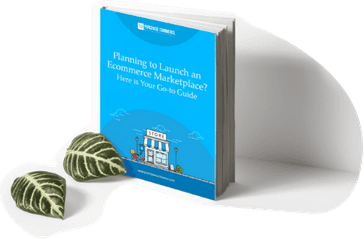How to Start Multi-Vendor Ecommerce Website with Purchase Commerce
All wish to have a successful multi-vendor marketplace and wanting to create your own?
With the massive success and popularity of websites like Amazon eBay, multi-vendor ecommerce marketplaces have become a popular way to sell both physical and digital products.
As customers are everyone will overjoy because they get to choose from a wide selection of products from multiple vendors, and you’re as an owner float in air because you get to charge vendors a commission. A multi-vendor marketplace requires unique functionality and feature. You need special software to handle all the activities if you want to create your own multi-vendor marketplace.
Most importantly, creating a multi-vendor marketplace is not that easy if you have been in this business.
There are lots of things need to consider will start a multi-vendor ecommerce platform. Let’s look at how to build a successful multi-vendor ecommerce marketplace.
What is an Online Marketplace?
If you want to understand the online marketplace, just compare it with a real-world big mall. Over their customers find many stores selling different products, or maybe similar products under one roof. In an online marketplace, multiple sellers come together on a website to sell their products or services, but there would be any physical conversion between them.
Customers can then visit the multi-vendor ecommerce website and buy products from one or multiple sellers without being concerned with whom they are buying from. For the customers, the website is the brand, not the individual sellers.
Some interesting business models to build your business on it
The marketplace is now mostly focused on consumer-to-consumer (C2C) and business-to-consumer (B2C) sales, and today these multi-billion business is widely spoken all over the world. There also many other business models in which the marketplace can run.
Business-to-Consumer(B2C) Operation
Business-to-consumer is used widely and well known for its sales models. The (B2C) refers to the selling of products or services directly to consumers by the owners. Most people prefer to sell in B2C due to its high revenue and easy mode of selling.
Any business that relies on B2C sales has good relations with its customers to ensure it satisfies them with their products or services. In B2C people make use of eliciting an emotional response in their marketing to the customers in a wide range.
Business to Business (B2B) Operation
B2B, is a refers to the transaction between businesses, people involved here will be anyone manufacturer and wholesaler, or a wholesaler and a retailer. Here the direct shipping to the customer also available for varies services if through third party members.
The revenue business model comprises 3 types mostly:
- Drop-Shipping
- Branding and Advertisements
- Auction
Branding and Advertisements
eBay also makes money from brands by providing them some ad spaces on the home page and advertisements are CPC based ads with some measurable ROI. Brands make use of this opportunity to better engage with eBay customers or re-target them and get noticed. Advertisers pay for each sale that happened during a period of 30 days from the date of a visitor clicking the promoted advertisement
Auction
People post a rare collection of items for sale on an auction or bidding basis, and the bidders place bids on the items. The revenue for this type is also a mix of listing fees and commission.
Drop-Shipping
Here sellers do not any stock of the products on their own. When a customer an item, the details are passed to the shipping provider. Then they will directly ship to the customers through the logistics process. Here the fee is a combination of listing plus commission, and the shipping partner’s fixed fee or floating commission is based on the product type.
Some Challenges faced in a multi-vendor business
Branding & Marketing: To make your bard visible to the customer in the pool of competitive world you need to market it well. Developing the marketplace involves a heavy price due to branding and marketing.
Declining Margins: With many products available as the same in the market selling margin is very low over a period.
Logistics and Supply Chain: Logistics malfunction in some regions can signify detrimental damage to a startup’s future as well as can spoil the brand overall. Add to this the need for guaranteed return policy. Getting this right is a challenge.
Steps to starting a Multi-Vendor Website
1. Less is More. Determine Your Niche
Overcome the temptation to serve all at once and do not try to build another eBay. It doesn’t mean you’ll never achieve it. Etsy started as craft supplies and tools market and has grown up into a global market.
First of all, you need to find a particular niche and give everyone a clear understanding of what exactly your marketplace is about.
So, narrow your focus (ideally on what you’re really good at), determine the type and category of your services or products, your target audience segments, and location. Finally, one day you’ll see that your marketplace reaches new heights. Thorough research and understanding of who they are helped our client to launch a successful print marketplace and start selling online more effectively.
2. Benefit from Competitors’ Weaknesses
Find the way you can be better than your competitors. It can be a unique inventory, a much better product/service or lower commission rates for vendors. Implement this feature starting from the very launch and don’t forget to mention it in your ads.
3. Find Vendors
To get inventory, you need to find suppliers. What can convince the sellers to list their products on your multi-vendor ecommerce website? Prepare a strong message and do your research.
Browse the internet for a start. Make a list by referring to online catalogs, social accounts, official websites, similar marketplaces, communities, and professional forums. It is also useful to visit special events and exhibitions. Reach the potential sellers by phone and by email.
Or, if you’ve decided to go with offline to an online model and your sellers are located nearby, arrange personal meetings with them. Make sure that you have an inventory or product management techniques before taking the vendors.
4. Attract Buyers
When you’re ready to accept orders, it’s high time to invite your customers. Tell them how your marketplace can resolve their problems or what a new experience it will deliver.
To attract buyers to your marketplace and promote it further, you’ll need to use various channels and marketing tactics. We’ll review them further in the article.
5. Supply, Customers, and Vendors are Important Rather than Development
You no need to have a big management team. Instead, it makes more sense to find a cost-efficient open-source ecommerce marketplace software that best suits your business and requires minimum effort from you.
Invest in establishing superb customer and vendor experience: build the buyer and vendor communities, offer excellent customer service and vendor assistance. make sure that you respond to the early adopters’ feedback and correct your marketplace arrangement and work.
Must-Have Features of a Multi-vendor Ecommerce Website

1. Multi-vendor Website Features from Customers’ Perspective
Easy Page Navigation
Make your customers walk in a well-trodden path of website navigation. Always make navigation extremely fast and easy to jump around. Only simple and easy navigation makes the customer more pleasurable and makes then to visit again.
Simple Checkout Page
The checkout page needs to more interactively for order processing. Reduce the number of steps to checkout, easy to understand, and smooth checkout options. Make your single page checkout process with Purchase Commerce software.
Order Notification
Our convenient order management protocol Send notifications to a store owner, vendors and customers informed using email and SMS. Purchase Commerce configures your site to keep track of vendor performance and order status like shipped or canceled.
Multilingual / Multi-currency
Make your website available in local language and local currency. If you have multilingual and multi-currency features on your website that will enhance the customer experience as shoppers will be able to view a website in their preferred language and pay in their preferred currency.
Multiple Payment Options
If you give more option and freedom for your customers to choose their preferred mode of payment, then will visit and prefer you for the next time. In the technical aspect, it increases the speed of the checkout process.
2. Multi-vendor Website Features from Sellers’ Perspective
Sellers are an equally important part of the business as customers. You need to make sure your sellers get the following features on your multi-vendor marketplace website.
Import/Export
You can export data like report and vendor details from the store to your store or even globally. If you from tax categories to catalogs to sell products, this feature allows sellers to import/export all the data that they want to migrate from their system to the ecommerce website.
Powerful Vendor Dashboard: Providing sellers/vendors a dashboard is a great idea for allowing them to manage their profile, their products, sales and inventory from one place.
Promotions
If you have inbuilt Pay per Click (PPC) advertising feature, it can help sellers promote their products and see how their ad campaigns are performing. This also reduces the seller’s overall marketing budget, cost per click and duration of a campaign, the promotion feature can help them increase their revenue.
Shipping Info
Always it is better to go with the shipment company of customer and vendors’ choice is a great way to enhance convenience for sellers. Moreover, notification helps sellers to inform their customers about the time that will take the product to reach their doorstep.
Multi-store Functionality
Having multi-store will help in boosting sales. If you offer a multi-store it makes more recognition and its facility to add as many stores as they have will be good for the vendor as well as the admin’s business.
3. Multi-vendor Website Features from Admins’ Perspective
Admins or owners are the people who own the ecommerce marketplace and make changes most often. They manage everything and everyone, including customers and vendors. And you need to have this following feature for admins to have complete control:
Product Catalog
It makes things easy for sellers and also makes admins a get to reduce the hassle of managing various stores. The catalog must be simple for all the vendors to add their product, product price, managing vendors doesn’t get easier than this.
Scalability and Customization
An ecommerce marketplace should grow in tandem with the growth rate of the business. admin needs to have the entire control for adding more vendors to adding more product categories. They should be able to add and customize the website as per their requirements.
Automated Task Processing
From setting commissions to real-time tax and shipping calculations, automation is the key to hassle-free marketplace management.
Report and Data
It was always important to analyzing sales or to keep track of if reports to campaign report to fetching customer data to make better recommendations. This feature helps admins grow their revenue multifold.
Any multi-vendor website that packs the features mentioned above can be touted as a perfect marketplace. With entrepreneurs falling short on time because of cutthroat competition, going for a turnkey ecommerce solution would be a smart business decision.
Conclusion
Setting a marketplace is quite a challenging task. You need to carefully study the needs and requirements of the marketplace before starting it. You can choose your platform depending on your requirements and budget. But before you finish your multi-vendor platform.
Purchase Commerce offers everything that is needed to set the marketplace easily. It offers you built-in tools and functionalities to manage a major task.









